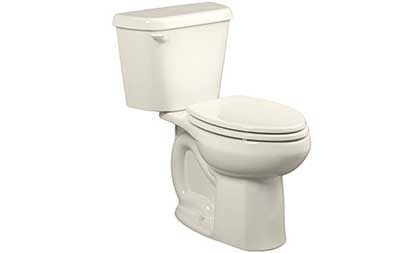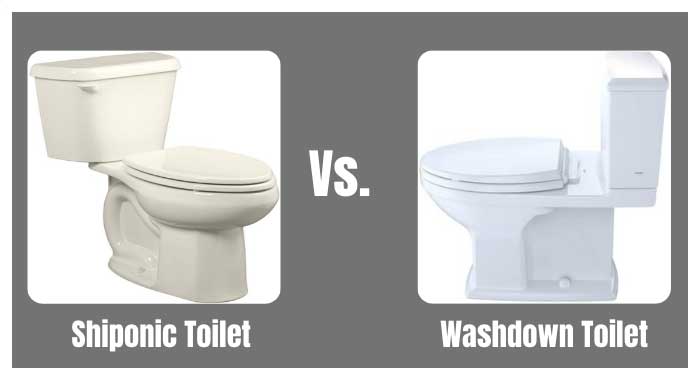So, you are looking for a brand new toilet to install in your bathroom? Well, we have good news for you; there are so many models and designs to choose from. Unfortunately, the existence of many options makes your research more time-consuming.
Before you settle on the toilet of your choice, note one thing; toilets have different flushing technologies. And because of this difference, flushing performance alters as well.
There are many flushing systems, but the common ones are siphonic and washdown. The crazy thing is many people don’t bother finding out what those two words mean and in return, end up frowning at their toilet’s flushing performance.
This article comprehensively dives into a comparison between siphonic and washdown toilets to help you understand which types suit your needs. Without wasting a second, let’s dive straight into the details.
Siphonic Toilets and How They Work

Siphonic toilets, also called gravity flush, are mostly distinguished by their S-shaped trapway. For those who don’t know, a trapway is a waste pipe through which waste comes out of the toilet and into the septic tank.
The S-shape of these toilets is not just a fancy design but a practical one. The bend slows the speed of water exiting the bowl while the tank delivers at a higher speed. Once the water rises to a good level in the bowl, the air in the trapway will be forced out leaving a vacuum suction force that quickly empties waste.
Some siphonic have their trapways skirted or concealed. This can make it hard to tell whether you are looking at one or a washdown toilet. In this case, you’ll have to direct your attention to the level of water inside the bowl (unfortunately, this trick helps only those shopping offline because you will have a chance to run some tests).
After a flushing session, the water level in a siphonic toilet sits at a higher level above the outlet hole compared to a washdown model. The purpose of that water is to form a seal that prevents odor from the sewer system from flying back to the bathroom. Also, siphon toilet bowls happen to be bigger-somewhere around 7’’ x 8’’.
There is no doubt siphonic toilets are common in many homes. But they have a few bottlenecks that impede performance. For instance, their long, narrow, and winding trapway is the major cause for clogging. This is why it’s always a good idea to have a plunger nearby for when shit starts to hit the fan (almost literally).
Secondly, the long S-shaped trapways mean the bowl needs to be bigger/longer for the toilet to work the way it is supposed to. This is an absolute bummer for anyone running out of bathroom space. But the good news is shorter models exist, and there is also the option to go for compact-size toilets.
Advanced Water-saving Designs
Previously, toilets used to flush at a rate of 3.5 gallons per flush. Lately, EPA policies drill for a flushing rate of either 1.6 GPF or lower in an effort to conserve water. The problem is, some toilets are so inefficient that you would be forced to flush them twice, which obviously beats the logic of saving water.
This is where the advanced bowl and trapway designs come in. if you look at no-clog toilets, you can sport glazed trapways that are ultra-smooth, so every piece of crap glides over into the waste system. So if you are looking for the best performing toilets, prioritize those with CEFIONTECT and Everclean surface finishes. They will be worth every penny in the long run.
Pros
- Silent flushing performance
- Odorless
- Water-saving
- Lower chances of the bowl getting stained
Cons
- Can clog easily
- Tend to take up a lot of space
What Are Washdown Toilets?
In a washdown toilet, the flowing water from the tank creates a pushing force that ejects waste matter. The pressure generated alone isn’t enough to kick the waste down. Instead, the trapway is almost 4-inches bigger than that of siphonic toilets to make waste removal as easy as possible.
You will notice that the bowl water level in washdown toilets sits a little lower on a 4’’ x 5’’ surface. This leaves plenty of room for waste so that pushing it down becomes less of a burden. Because of this design, these toilets tend to be space-saving.
Most washdown toilets bear dual flushing systems. This can be convenient and cost-saving as they allow you to flush solid and liquid waste using different amounts of water. And when it comes to maintenance, practically all toilets suffer from the same defects like clogs, valve faults, worn-out seals, and much more.
Pros
- Clog-free performance
- Space-saving bowls
- Use less water
- Easy to maintain
Cons
- The lower water level makes outward splashes possible
- Less water in the bowl could mean more odor
Wrap Up
Siphonic vs. washdown toilet-which is better between the two? Well, the answer is simple; it all depends on your preference. Washdown toilets are common in European countries, while siphonic are common in American homes.
Next, you will have to consider the amount of space in your bathroom. Those who lack space or are usually taller people will find washdown toilets to be space-saving compared to siphonic toilets. They are also ideal in homes that receive a lot of waste as they clog less often.
If you are an ardent lover of siphon toilets and have many kids, try high-end toilets with ultra-powerful modern flushing systems, so you don’t have to use a plunger often.
Related Resources

